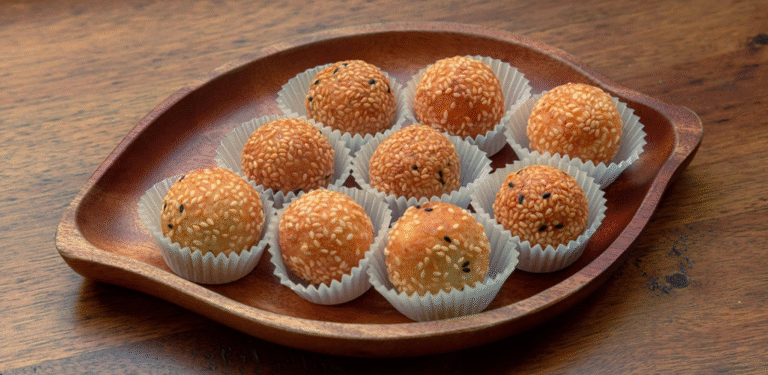Sesame Balls
If you’re looking for dessert on the richer side, something deep fried and crispy always delivers. This sesame balls recipe (Vietnamese bánh cam) satifies snack cravings with a crispy golden glutinous rice outer shell, filled with sweet mung beans, and covered in white sesame seeds.

Sesame balls are a ubiquitous snack across the rice-growing regions of China, gracing both dimsum banquet halls in the South, where they are known as jiandui, and street stalls in the Yangtze River delta, where we call them matuan. Sesame balls stuffed with silky red bean paste — crunchy, chewy, and sweet — are the earliest treats I can recall.
These days, sesame balls with no filling are all the rage in China — the balls puff up in oil and become hollow inside like a beignet. And like a beignet, it’s hard to eat just one. But if you want to fill your sesame balls, there is no shortage of classic options, many of which can be found pre-made at Asian grocery stores (or online).
- Red bean paste
- Mung bean paste
- Lotus seed paste
- Taro paste
- Black sesame paste
- Crushed peanuts
Because sesame balls are basically mochi donuts, they can be stuffed with pretty much anything. The sticky rice dough provides a gently sweet and versatile backdrop for all manner of flavors. Feel free to get creative with your fillings. I bet Nutella or even cheesecake would be amazing twists.
The Fillings in This Recipe
I’ve included two optional fillings in this recipe: a classic mung bean filling, and a more modern “black sugar sesame” filling, inspired by black sugar boba, the latest Taiwanese boba trend to take over the world. My mung bean paste calls for green unhusked mung beans, which makes a chunky filling (yes, I also like pulp in my OJ). If you prefer a smooth filling, substitute husked yellow mung beans (or buy a ready-made paste). As for the black sugar filling, I use black sesame seeds as the foundation and add loads of Taiwanese black sugar, which is an intense, unrefined cane sugar whose closest cousins are jaggery and piloncillo. The black sugar adds fruity acidity and caramel flavors to the filling, and if you have these sesame balls with a glass of milk, you might be convinced you’re at Tiger Sugar. Black sugar is available for sale online, but if you’re unable to find it, don’t worry: Substitute with any other unrefined sugar, or use regular dark brown sugar and add a spoonful of molasses.
Sticky Rice Flour
One ingredient that cannot be substituted is sticky rice flour, also known as glutinous rice flour. Asian brands such as Koda Farms or Erawan sell traditional water-milled sticky rice flour, which has a texture like powdered sugar and is ideal for sesame balls. I had less success getting my dough to be as soft and absorbent when using non-Asian brands like Bob’s Red Mill. Whatever you do, don’t use regular rice flour, which is an entirely different thing!
The Science of Sesame Balls
You may have heard that sesame balls will explode if you fry them incorrectly, and it’s true — even if the balls have no filling (something I learned the hard way). When a sesame ball is deep-fried, the water in the dough evaporates out and the steam causes the dough to expand. If this process happens too quickly or unevenly, or if the dough itself is unevenly mixed, it cannot stretch properly and therefore explodes. Many recipes also call for baking powder, which is meant to chemically aid the natural steam-powered puffing of the sesame ball, but it can cause too-fast expansion and subsequent explosion. The low-and-slow frying technique in this recipe is my mom’s, and it produces safe, consistent results, as well as sesame balls that stay crunchy after cooling. Please pay specific attention to the following:
- The amount of sugar in the dough: Sugar helps the rice flour expand when heated. Not enough sugar may cause cracking and/or explosions.
- The texture of the dough: Sesame balls should be fried immediately after shaping, when the dough is still soft and moist.
- The temperature of the oil: In the first 10 minutes of frying, as each sesame ball is expanding, oil temperature over 300°F may cause explosions. Only let the temperature exceed 300°F during the final minutes if you want your sesame balls to take on more color. An accurate thermometer is key!
- The movement of the sesame balls: To ensure that all sides fry at the same rate, movement should be constant.
- The shape of the sesame balls as they fry: Balls that become pear-shaped will imminently explode and should be scooped out immediately.
- Your person: Wear long sleeves and do NOT stand with your face over the oil!